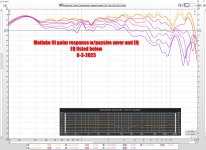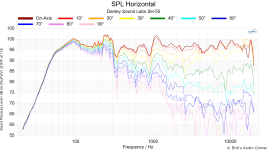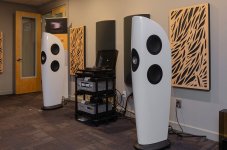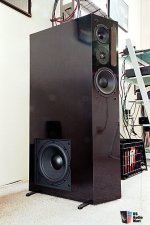Good things comes to he who waits – well sort of
-- Or –
If you can’t afford a new Corvette, what’s wrong with a late-model Camaro?
After years of being a Danley fanboy, much recounted on this very site, I have finally bought a pair.
Not the coveted SH50. Nor the perhaps more appropriate SM60F. It’s worth mentioning that the latter have nearly doubled in price in the past several years, pretty sure. OK, I’m such a genius, why didn’t I buy a pair years ago? I had the funds. But even worse – in a way – I snagged a pair of very beat up Yorkville Unity U15 in about 2015. Slightly tweaked, these have provided excellent sound for eight years. Even the best Danley, I rationalized, might only be an incremental improvement over what I had. But even so, I couldn’t shake the feeling that I was – to return to the car metaphor – driving around in a 1992 Pontiac Firebird, in pretty good shape all things considered, but one that left a cloud of blue smoke when I accelerated.
And perhaps that will prove a correct analysis. But now I’ve scratched my itch, as well as (hopefully!) reducing my costs if I’m wrong. Consider the following, which should apply to most high-end audio, as well as much else:
Bought new, there’s usually quite high dealer mark-up. I don’t know what it is in Danley case; I would guess 100%. A recent quote on a single SM60F, for example, is $4250 + tax + shipping. That’d bring the cost up to perhaps $4,700 each.
They are quite rare on the used market, at least on EBay. An “open box” pair of “SM60MH” (active) sold for “best offer” probably just under $4500. So we can guess used $2,200/each. New? I’d guess $3000-3500, but really don’t know for sure. Active would add cost, but on the other hand, the SM60MH is not the equal of the SM80.
On a strict comparison basis, the SM80 trounces the SM60 both in maximum output as well as frequency response, as one would expect in a contest between a 12-inch coaxial vs. a 5-inch. On the other hand, the SM60M is a “true” Synergy horn (= separate mid ports). Whether this translates into superior perceived quality, I don’t know, and couldn’t possibly know, unless I had two pair to audition, of course.
Anyway, back to my current buy. I’ve finally gotten the chance to audition a Danley speaker. If I don’t like them, in all probability I will be able to re-sell them for close to what I paid for them. Unlike the SM60x, the SM80 sell more often. There were two earlier sales (EBay), one at $4,100 and another at $5,000.
I rather like the used market. What it lacks in convenience and availability, it usually more than makes up for in terms of value.
-- Or –
If you can’t afford a new Corvette, what’s wrong with a late-model Camaro?
After years of being a Danley fanboy, much recounted on this very site, I have finally bought a pair.
Not the coveted SH50. Nor the perhaps more appropriate SM60F. It’s worth mentioning that the latter have nearly doubled in price in the past several years, pretty sure. OK, I’m such a genius, why didn’t I buy a pair years ago? I had the funds. But even worse – in a way – I snagged a pair of very beat up Yorkville Unity U15 in about 2015. Slightly tweaked, these have provided excellent sound for eight years. Even the best Danley, I rationalized, might only be an incremental improvement over what I had. But even so, I couldn’t shake the feeling that I was – to return to the car metaphor – driving around in a 1992 Pontiac Firebird, in pretty good shape all things considered, but one that left a cloud of blue smoke when I accelerated.
And perhaps that will prove a correct analysis. But now I’ve scratched my itch, as well as (hopefully!) reducing my costs if I’m wrong. Consider the following, which should apply to most high-end audio, as well as much else:
Bought new, there’s usually quite high dealer mark-up. I don’t know what it is in Danley case; I would guess 100%. A recent quote on a single SM60F, for example, is $4250 + tax + shipping. That’d bring the cost up to perhaps $4,700 each.
They are quite rare on the used market, at least on EBay. An “open box” pair of “SM60MH” (active) sold for “best offer” probably just under $4500. So we can guess used $2,200/each. New? I’d guess $3000-3500, but really don’t know for sure. Active would add cost, but on the other hand, the SM60MH is not the equal of the SM80.
On a strict comparison basis, the SM80 trounces the SM60 both in maximum output as well as frequency response, as one would expect in a contest between a 12-inch coaxial vs. a 5-inch. On the other hand, the SM60M is a “true” Synergy horn (= separate mid ports). Whether this translates into superior perceived quality, I don’t know, and couldn’t possibly know, unless I had two pair to audition, of course.
Anyway, back to my current buy. I’ve finally gotten the chance to audition a Danley speaker. If I don’t like them, in all probability I will be able to re-sell them for close to what I paid for them. Unlike the SM60x, the SM80 sell more often. There were two earlier sales (EBay), one at $4,100 and another at $5,000.
I rather like the used market. What it lacks in convenience and availability, it usually more than makes up for in terms of value.
Danleys can be found, but most buyers regard them as the last speakers that they'll ever buy. They are big in the "houses of worship" market, and that's where I found my SH50 pair. I don't know what the planned replacement was, but the price to me was fair.
Glad you finally ended up with some. Mine are wonderful, but a bit much in my 11 x 12' room. Tom is a national treasure.
Glad you finally ended up with some. Mine are wonderful, but a bit much in my 11 x 12' room. Tom is a national treasure.
I looked for Danley on ebay for a few months. If I bought something as big as 2 Sh50's, I would have to buy a church auditorium to go with it. I don't need a bigger house, I would have to heat & cool it. Plus lots of upholstered seats & carpet to kill the reflections off a hard concrete floor and masonry walls. Heat+cooling+roof maintenance cost is what causes a lot of churches to fold and put the SH50's on the market. I respect Mr. Danley especially for employing my neighbors, but for my 14'Lx11'Hx30'L room, the Yorkville U15's would be a better fit. They were on my search list, along with some JBL models when my SP2-XTs were stolen by an admirer. Peavey SP2(2004) is what I have now, no complaints. I don't miss the 17000-20000 hz, I can't hear higher than 14000.
Last edited:
The HOW market is a very saturated market and just about any manufacturer wants a piece of it. Problem is the market is too crowded in terms of overlapping designs and many of them are just regurgitated old junk that has a huge price tag. The people who are in this market are easy to convince they need some kind of overkill setup and don't know their actual needs. Alot of the people don't have a clue about sound reinforcement yet they are in charge of the purchase process. I'm glad I dont deal with these people anymore as they usually read about it online and want big toys to play with.
I think there are a bunch or erroneous conclusions in those statements.I looked for Danley on ebay for a few months. If I bought something as big as 2 Sh50's, I would have to buy a church auditorium to go with it. I don't need a bigger house, I would have to heat & cool it. Plus lots of upholstered seats & carpet to kill the reflections off a hard concrete floor and masonry walls. Heat+cooling+roof maintenance cost is what causes a lot of churches to fold and put the SH50's on the market.
The reason the SH50 is 'large' is simply about pattern control, to achieve a relatively narrow 50x50 pattern .
The frontal 28" x 28" still only gets to about 700Hz control.
And there's certainly a lot of install speakers, or home audio freestander, with greater baffle area.
The 23" depth is what is takes for the horn to hold the 50x50 pattern.
What kinda 'large' are we really talking about.....
Plus, the speakers size is much less about needing a big space, much less about killer high SPL, .....than it is about the defined narrow pattern.
And for not needing upholstered seats or carpet as much, because it helps keeps direct sound off the floor.
It's a dang good small space speaker imo, if you like higher direct to reflected.
Anyway, the whole heating + cooling + roof maintenance extrapolation...into the idea a big room is needed to support a SH50 .....seems frankly, pretty darn silly....
along with the idea that's what causes churches to fail and put SH50's on the market.
Willing to learn. Personally, I like wide dispersion so I can walk around my deadened room & sound doesn't change. So, thanks. I don't need a narrow pattern SH50.The reason the SH50 is 'large' is simply about pattern control, to achieve a relatively narrow 50x50 pattern .
The frontal 28" x 28" still only gets to about 700Hz control.
...The 23" depth is what is takes for the horn to hold the 50x50 pattern.
What kinda 'large' are we really talking about.....
Plus, the speakers size is much less about needing a big space, much less about killer high SPL, .....than it is about the defined narrow pattern.
+1, math for those interested: 10^6/(28*50) = ~714 Hz/-F6The reason the SH50 is 'large' is simply about pattern control, to achieve a relatively narrow 50x50 pattern .
The frontal 28" x 28" still only gets to about 700Hz control.
-F6 = (2.54*10^6)/(baffle*wall angle) in cm
I think there are a bunch or erroneous conclusions in those statements.
The reason the SH50 is 'large' is simply about pattern control, to achieve a relatively narrow 50x50 pattern .
The frontal 28" x 28" still only gets to about 700Hz control.
And there's certainly a lot of install speakers, or home audio freestander, with greater baffle area.
The 23" depth is what is takes for the horn to hold the 50x50 pattern.
What kinda 'large' are we really talking about.....
Not true.
My big 'eureka' moment with a lot of these waveguides, was listening to the Revel speakers with a 6" wide waveguide and the JBL 4367 back-to-back. JBL waveguide is something like 18" wide.
It was shocking how similar the sound was.
That put the idea in my head that you really can't evaluate a waveguide without considering the size and shape of the enclosure that it's put in. Basically, a carefully optimized enclosure can maintain the directivity control by as much as 1-2 more octaves. Which means that a 15cm waveguide which should theoretically lose pattern control at 2267Hz can actually work all the way down to 1khz or even lower.
Attached are polar measurements of my latest speaker (waveguide is about 38cm wide, 894Hz is 38cm long) and the Danley SH50 (waveguide is 71cm wide, 478Hz is 71cm long.)
In a nutshell, my speaker should theoretically lose pattern control at 894Hz, but it works to 450Hz, and the SH50 should theoretically lose pattern control at 478Hz but it works to 250Hz.
Note that my measurement goes to 45 degrees off axis while the SH50 goes to 90 degrees off axis, so focus on the first half of the SH50 traces to do a proper comparison.
I have a shiny new (to me at least) Xeon workstation here with a pile of RAM and CPU cores, and I need to dig into this one further, but I have a 'hunch' that this phenomenon can be taken a step further by going kinda crazy with the depth of the baffle, a la the NHT speakers from 30 years ago. (pic attached.) To do it properly, the baffle would need to be mostly symmetrical like the Kef blade (also attached.)
There's some common ground with the ambiophonic ideas here too, because in a lot of ways a speaker like the NHT is basically acting like a barrier that divides the room in half, similar to how a good ambio setup can be achieved with zero processing and a physical barrier. I think we've only scratched the surface of this, because to really do this right, it may be optimal to have a metamaterial surface, or some type of absorptive surface, or a specular surface. If the Kef metamaterial technology has taught us anything, it's that the most effective place to "treat the room" isn't the walls of the room itself, it's the first 0.5-1.0 meters around the speaker. I've posted videos of Metlako III playing music, and it's rather startling how quickly the SPL levels fall off as you move away from the speaker. This is because it's a point source and when sound is radiating spherically, it falls off in a hurry. Conventional speakers don't do that well, because in the most important rage (the mid range) the relationship between midrange and tweeter is very complex. In a conventional two-way, the radiation is anything but spherical at the typical crossover point of about 2khz, as well as a range bracketed above and below the xover point. This can be easily seen in the vertical polars.
Attachments
Last edited:
Hi indianojo, yep we all like what we like.Willing to learn. Personally, I like wide dispersion so I can walk around my deadened room & sound doesn't change. So, thanks. I don't need a narrow pattern SH50.
hey, sorry for going off so strong in my previous reply...uncalled for...got irritated elsewhere and went nutz here.
Not true.
My big 'eureka' moment with a lot of these waveguides, was listening to the Revel speakers with a 6" wide waveguide and the JBL 4367 back-to-back. JBL waveguide is something like 18" wide.
It was shocking how similar the sound was.
That put the idea in my head that you really can't evaluate a waveguide without considering the size and shape of the enclosure that it's put in. Basically, a carefully optimized enclosure can maintain the directivity control by as much as 1-2 more octaves. Which means that a 15cm waveguide which should theoretically lose pattern control at 2267Hz can actually work all the way down to 1khz or even lower.
Attached are polar measurements of my latest speaker (waveguide is about 38cm wide, 894Hz is 38cm long) and the Danley SH50 (waveguide is 71cm wide, 478Hz is 71cm long.)
In a nutshell, my speaker should theoretically lose pattern control at 894Hz, but it works to 450Hz, and the SH50 should theoretically lose pattern control at 478Hz but it works to 250Hz.
Note that my measurement goes to 45 degrees off axis while the SH50 goes to 90 degrees off axis, so focus on the first half of the SH50 traces to do a proper comparison.
Hi Patrick, We appear to have different understandings of "pattern control"
My understand is that it means: referenced to some quoted angle, how low in frequency does a horn/waveguide hold radiation to that angle, before the radiation widens beyond that angle. And that frequency, is customarily quoted at f-6.
So in the case of the SH50, its horizontal control needs to be assessed in terms of its 50 H deg reference angle.
I haven't seen what you consider you speaker's pattern control angles. (H-V pattern)
I go by Keele's classic rule of thumb formula that GM showed in #8.
This simple formula is of course for a single section's horn/waveguide wall angle, and putting a horn/waveguide into a larger baffle will obviously lower the frequency pattern some, before control collapses. Ala a simple baffle step effect (better said baffle ramp imo)
On the SH50 polars you posted, my understanding of pattern control leads me to look from the high freq end down, to where 25 degrees off axis, begins to get closer than -6dB to on-axis response. I'd say that is occurring somewhere around 600Hz...fairly close to the 714Hz rule of thumb calc. (Looking between the SH50's yellow and orange polar traces you posted.)
Anyway, I'm self taught and find myself misconstruing things every now and then.....
How are you using the term pattern control?
Thank you for this. I've been looking for this formula to figure out the directivity control of a deep cabinet which happens to act like the blade. Audio Physics had a similar type of setup but non-symmetrical, which may skew the math a bit.+1, math for those interested: 10^6/(28*50) = ~714 Hz/-F6
-F6 = (2.54*10^6)/(baffle*wall angle) in cm
The phase relationship between the front and side drivers acts like a reverse WG taper, achieving similar pattern control like an MEH but with the baffle surface wrapping around itself. I would assume some selectable pattern hypercardioid microphones do this as well with their phasing slots.
Does anyone know specifically what the xover frequency and polar plot is on the blade? Sorry for the sidetrack of topic.
Which Revels? To me, that confirms the theory that any particular directivity is less important than a smooth on-axis response and uniform off-axis response. Note: uniform, not constant. The ears spot differences, both within the on-axis response and between on- and off-axis responses.My big 'eureka' moment with a lot of these waveguides, was listening to the Revel speakers with a 6" wide waveguide and the JBL 4367 back-to-back. JBL waveguide is something like 18" wide.
It was shocking how similar the sound was.
@profiguy,
Not a definitive answer about Blade behavior but interesting nonetheless:
https://www.diyaudio.com/community/threads/tachi-coaxial-point-source-bem-modelling.386711/
Xover at 350hz/2khz for Blade 1 meta.
@Soldermizer: nice catch!
Now you need to make space for them so i sacrifice myself: i'll take the Yorkville. I'll send you my adress by pm. 🙂
Not a definitive answer about Blade behavior but interesting nonetheless:
https://www.diyaudio.com/community/threads/tachi-coaxial-point-source-bem-modelling.386711/
Xover at 350hz/2khz for Blade 1 meta.
@Soldermizer: nice catch!
Now you need to make space for them so i sacrifice myself: i'll take the Yorkville. I'll send you my adress by pm. 🙂
@Soldermizer, congrats ! Looking forward to hearing how you like them.
What are you planning on using for subs? And where crossing?
As you no doubt know, they're a favorite among live-sound operators.
What are you planning on using for subs? And where crossing?
As you no doubt know, they're a favorite among live-sound operators.
Thanks! I won't have them before Saturday. But I'll be sure to post a review. For subs, I plan to just continue using my "Frankenclosure" project from nearly ten years ago (!!!) [I just browsed my archieve here -- yes long ago, I made a half-assed attempt at a tapped horn. Only the original woofers (and some unremobable roofing tar stains on a floor) remain to tell the tale... They've provided decent service most of that time period. Nothing fancy: each is a 2' cube with a single Alpine 15" SWS-15D4 auto subwoofer driver. For the U15's I had them high passed around 50 Hz. The SM80s by their chart, look like they run out of gas < 140 Hz, the recommended processing is high pass @ 110 Hz. Obviously a single 15" isn't going to "keep up" with the SM80. But in my living room, it doesn't have to.
Krivium: I'm not ready to sell the U15s yet. To judge from your flag, shipping might be uneconomcial 😱
Now, with my luck, a pair of SM60F and/or SH50 will pop up at a cheap price...
"Not once in eighteen years, and now, twice in one day!" -- character Den in the movie "Heavy Metal", exclaiming on the sudden change from geek to super stud. 😎
Krivium: I'm not ready to sell the U15s yet. To judge from your flag, shipping might be uneconomcial 😱
Now, with my luck, a pair of SM60F and/or SH50 will pop up at a cheap price...
"Not once in eighteen years, and now, twice in one day!" -- character Den in the movie "Heavy Metal", exclaiming on the sudden change from geek to super stud. 😎
Last edited:
Today I got an email (Ebay alert): churchgear (a major reseller) has a major listing of Danley gear on Ebay. I think there may be errors, though: for example, about half dozen listings for seemingly the same pair of SM60F and 4xSH50 that was in email but listing removed. In any event, I shall be trying to buy some of the gear if a valid listing pops up. I'll worry about how to pay for it later.
Just pulled the trigger on a pair of SH60. "Nothing exceeds like excess", someone once said. I was still toying with the idea of buying a pair of SM60F but perhaps I should quit before I turn into a wholesale distributor. 😁
The only thing I'm annoyed at 😠 is that a mere three days after pouncing on the SM 80s, came the slew of of more appropriate models. The prices seem very good, for anyone thinking to buy a pair. Probably half or less of what they cost new. Also with at least the in theory easy resale if you don't like them. Meanwhile the GO2 languish unloved 😊
The only thing I'm annoyed at 😠 is that a mere three days after pouncing on the SM 80s, came the slew of of more appropriate models. The prices seem very good, for anyone thinking to buy a pair. Probably half or less of what they cost new. Also with at least the in theory easy resale if you don't like them. Meanwhile the GO2 languish unloved 😊
- Home
- Loudspeakers
- Multi-Way
- Finally! Bought a pair of real Danley



